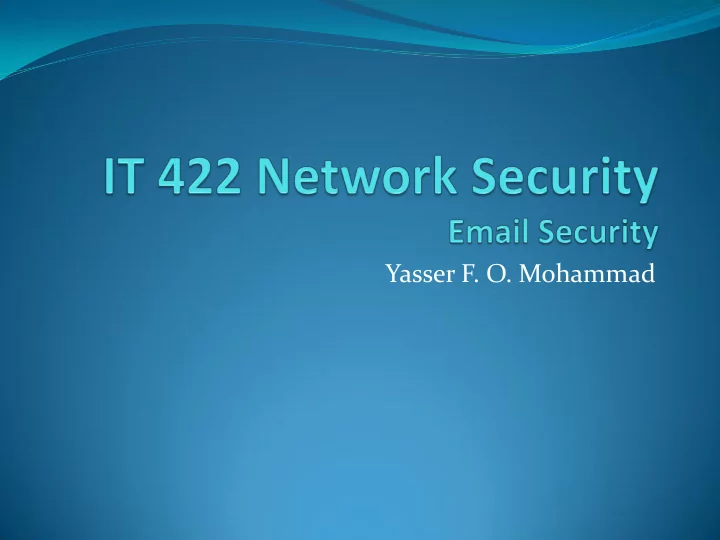

Yasser F. O. Mohammad
REMINDER 1: What is X.509? Part of X.500 standard for directory services Recommended by ITU-T in 1988 Used in many applications SSL/TLS S/MIME IP Security SET etc No specific public key algorithm but usually RSA
REMINDER 2: How certificates are signed?
REMINDER 3: Example CA hierarchy B can get the public key of A using the chain: Z<<Y>> Y <<V>> V <<W>> W <<X>>X <<A>>
REMINDER 4: PKIX End entity: End users, devices (e.g., servers, routers), etc Certification authority (CA): The issuer of certificates and (usually) certificate revocation lists (CRLs). Registration authority (RA): The RA is often associated with the End Entity registration process. CRL issuer: An optional component that a CA can delegate to publish CRLs. Repository: Any method for storing certificates and CRLs.
Email Security Current email protocol is not secure Any one can read the message During transmission In destination (with appropriate privilage)
How can Email be enhanced confidentiality protection from disclosure authentication of sender of message message integrity protection from modification non-repudiation of origin protection from denial by sender
What will we talk about PGP Pretty Good Privacy S/MIME International Standard
PGP widely used developed by Phil Zimmermann Selected best cryptographic building blocks integrated into a single program available on many platforms Both free and commercial version are available
Notation
Building Blocks
Authentication
Confidentiality A B: E(PU B ,K ab )||E(K ab ,M) Symmetric key 128 CAST or IDEA or 3DES Public Key RSA or ElGamal No shared key distribution problem
Authentication with Confidentiality
Compression Signature before Compression: No need to store the compressed version for future verification Many compression variations exist for different compression ratios. Encryption after compression: Less redundancy in plain text
E-mail compatibility RADIX64 is used to convert the binary converted part to ASCII for traditional email systems Each 6 bits are converted to 8 Can be applied to whole message or encrypted parts only
Transmission and Reception
Segmentation and Reassembly If message size is too large Segment it after all other steps Reassemble it before all other steps
Key types Session Keys Public Keys Private Keys Pass-phrases How to generate them? How to allow multiple Public/Private key pairs (updates)? How to store my private and others public keys?
Session Key Generation Use timing of keyboard strokes to generate a 128 bits random number Apply CAST to this number as 2 input blocks using CFB mode and some fixed random key The output (2 blocks) is used as the session key
Multiple Public keys Each public key of each user has an ID User ID + Key ID specify the Public key pair used KeyID is transmitted with the message in plain KeyID = Least significant 64 bits of the Public Key
General PGP message
Key Ring
How to protect the private key Store E(K,PR) K is generated from a user defined pass-phrase
Sending a message
Receiving a message
Public Key Management Self Read
S/MIME S/MIME (Secure/Multipurpose Internet Mail Extension) is a security enhancement to the MIME Internet e-mail format standard, based on technology from RSA Data Security Expected to be the standard Email security scheme while PGP stays a preferred personal solution
RFC 822 (EMAIL) Message= Envelop + Content Envelop is used for transmission Content is delivered to recipient Envelop = Headers Separated from content by an empty line!!
MIME Multipurpose Internet Mail Extensions Five new header fields A number of content formats Transfer encoding
New Header Fields MIME-Version: Must have the parameter value 1.0. Content-Type: Describes the data contained in the body. Content-Transfer-Encoding: Indicates the type of transformation that has been used. Content-ID: Used to identify MIME entities uniquely in multiple contexts. Content-Description: A text description of the object with the body.
MIME Content types
Example From: Nathaniel Borenstein <nsb@bellcore.com> To: Ned Freed <ned@innosoft.com> Subject: Sample message MIME-Version: 1.0 Content-type: multipart/mixed; boundary="simple boundary" This is the preamble. It is to be ignored, though it is a handy place for mail composers to include an explanatory note to non-MIME conformant readers. simple boundary This is implicitly typed plain ASCII text. It does NOT end with a linebreak. simple boundary Content-type: text/plain; charset=us-ascii This is explicitly typed plain ASCII text. It DOES end with a linebreak. simple boundary This is the epilogue. It is also to be ignored.
MIME Transfer Encodings
Functions of S/MIME Enveloped Data Confidentiality Signed Data Authentication Clear-signed Data Authentication (RADIX64 applied to signature only for readability) Signed and Enveloped Data Confidentiality and Authentication
S/MIME Algorithms
S/MIME Content Types
EnvelopedData Generate a pseudorandom session key for a particular 1. symmetric encryption algorithm (RC2/40 or tripleDES). 2. For each recipient, encrypt the session key with the recipient's public RSA key. For each recipient, prepare a block known as RecipientInfo 3. that contains an identifier of the recipient's public-key certificate, [3] an identifier of the algorithm used to encrypt the session key, and the encrypted session key. 4. Encrypt the message content with the session key.
SignedData Select a message digest algorithm (SHA or MD5). Compute the message digest, or hash function, of the content to be signed. Encrypt the message digest with the signer's private key. Prepare a block known as SignerInfo that contains the signer's public-key certificate, an identifier of the message digest algorithm, an identifier of the algorithm used to encrypt the message digest, and the encrypted message digest.
Types of Verisign Certificates Class Identity Checks Usage 1 name/email check web browsing/email 2+ enroll/addr check email, subs, s/w validate 3+ ID documents e-banking/service access
Recommend
More recommend